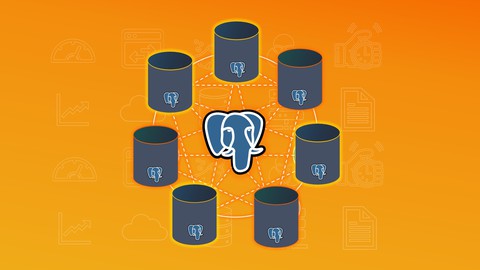Introduction to Scaling PostgreSQL
- Why scale PostgreSQL?
- What is Vertical Scaling?
- What is Horizontal Scaling?
- Read Versus Write Bound Workloads
- Why Statistics are essential?
- How to enable and make us of Statistics? (Hands-on)
- How to scale Postgres for Reads?
- How replication helps to scale out?
- What are the Load-Balancers?
- How to scale Postgres for Writes?
- How to make use of Queues?
- How could Partitioning and Sharding help in scaling out?
- What is the Multi-Master solution about?
Understanding the Limitations of Scaling out PostgreSQL
- CAP Theorem Explained
- PostgreSQL vs. Cassandra
- Use case: CA Systems
- Use case: AP Systems
How to use Streaming Replication?
- What is Streaming Replication?
- Asynchronous vs. Synchronous Replication
- How to Initialise Primary Database? (Hands-on)
- How to Configuring the Primary for Replication? (Hands-on)
- How to Configuring the Replica Instance? (Hands-on)
- Testing Replication Setup (Hands-on)
How to use Logical Replication?
- What is Logical Replication in Postgres?
- Step by step Logical Replication setup
- How to setup the servers for Logical Replication? (Hands-on)
- How to make a selective Copy of the Data? (Hands-on)
- How to Create the Publication? (Hands-on)
- How to Create the Subscription? (Hands-on)
- Postgres Limitations of Logical Replication
- How to Monitoring Logical Replication? (Hands-on)
- Best use-cases for using Logical Replication
How to make use of PgBouncer?
- What is PgBouncer?
- Fundamental concepts of connection pooling
- How to build a PgBouncer Setup? (Hands-on)
- How to install and configure PgBouncer? (Hands-on)
- How to create a basic configuration file for PgBouncer? (Hands-on)
- How to connect to PgBouncer? (Hands-on)
- Explaining Advanced Settings for Performance
- Which are the available Pool Modes?
- Executing a benchmark with PgBouncer (Hands-on)
How to scale PostgreSQL in Google Cloud?
- Introduction
- Key Components on Google Cloud
- Key Characteristics of the Architecture
- How to create PostgreSQL Instances on Google Cloud? (Hands-on)
- How to create a Google Cloud Engine (GCE) for HAProxy? (Hands-on)
- How to configure HAProxy for Load-Balancing? (Hands-on)
- Testing Load-Balancing
How to make use of PostgreSQL Partitioning?
- What is Partitioning?
- Which Tables Need Partitioning?
- How should the Tables be Partitioned?
- Declarative vs. Inheritance Partitioning
- How to create a Partitioned Table? (Hands-on)
- Partitioning Methods
How to Shard PostgreSQL?
- What is Sharding?
- Pain-Points of Sharding?
- What is Second Level Sharding?
- What is good Sharding?
- How to query across multiple Shards?
How to setup High Availability (HA) on PostgreSQL?
- Why High Availability?
- Steps to achieve High Availability
- Essential Questions to ask before setting-up High Availability
- Log-Shipping Replication
- Streaming Replication and Logical Replication
- Cascading Replication
- Synchronous vs. Asynchronous Replication
- Automatic Failover and Always-on Strategy
- Simple HA Solution Example
- Better HA Solution Example
How to make use of PgPool II?
- What is PgPool II?
- Pgpool-II Features
- How to Configure Pgpool-II with Streaming Replication? (Hands-on)
- How to setup Streaming Replication? (Hands-on)
- How to Configuring Pgpool-II for Load Balancing ? (Hands-on)
- Testing load-balancing & read/write separation (Hands-on)
- How to Configure Pgpool for PostgreSQL High-Availability? (Hands-on)
- How to Configure PostgreSQL Primary Server? (Hands-on)
- How to Configure Pgpool-II Server? (Hands-on)
- How to Configure PostgreSQL Replica Server? (Hands-on)
- Testing The Failover (Hands-on)
- How to restore failed nodes? (Hands-on)
Who this course is for:
- Software Engineers interested in designing Scalable and HA solutions on top of PostgreSQL
- Database Administrators
- Everyone interested in building better PostgreSQL applications
Can I download PostgreSQL Replication, High Availability HA and Scalability course?
You can download videos for offline viewing in the Android/iOS app. When course instructors enable the downloading feature for lectures of the course, then it can be downloaded for offline viewing on a desktop.Can I get a certificate after completing the course?
Yes, upon successful completion of the course, learners will get the course e-Certification from the course provider. The PostgreSQL Replication, High Availability HA and Scalability course certification is a proof that you completed and passed the course. You can download it, attach it to your resume, share it through social media.Are there any other coupons available for this course?
You can check out for more Udemy coupons @ www.coursecouponclub.com
Note: 100% OFF Udemy coupon codes are valid for maximum 3 days only. Look for "ENROLL NOW" button at the end of the post.
Disclosure: This post may contain affiliate links and we may get small commission if you make a purchase. Read more about Affiliate disclosure here.
Disclosure: This post may contain affiliate links and we may get small commission if you make a purchase. Read more about Affiliate disclosure here.


